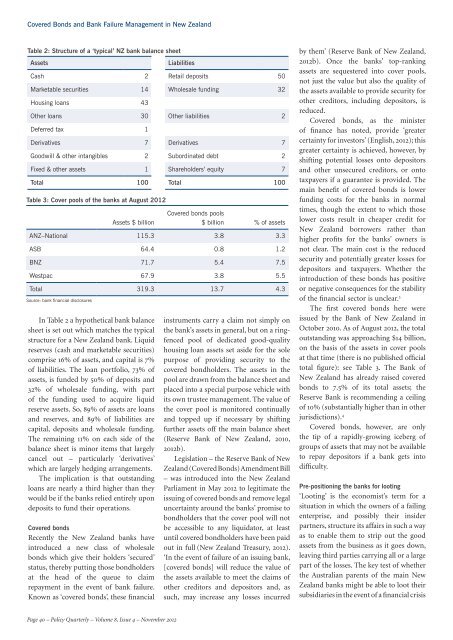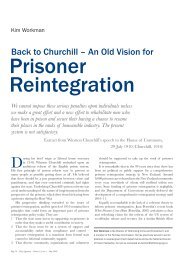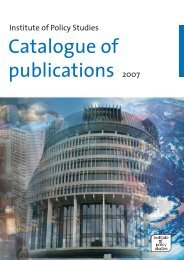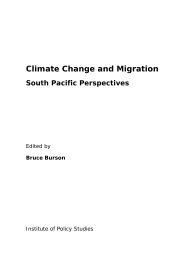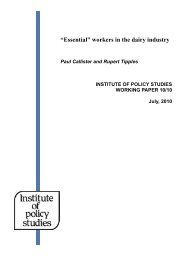PDF File - Institute for Governance and Policy Studies - Victoria ...
PDF File - Institute for Governance and Policy Studies - Victoria ...
PDF File - Institute for Governance and Policy Studies - Victoria ...
You also want an ePaper? Increase the reach of your titles
YUMPU automatically turns print PDFs into web optimized ePapers that Google loves.
Covered Bonds <strong>and</strong> Bank Failure Management in New Zeal<strong>and</strong><br />
Table 2: Structure of a ‘typical’ NZ bank balance sheet<br />
Assets<br />
In Table 2 a hypothetical bank balance<br />
sheet is set out which matches the typical<br />
structure <strong>for</strong> a New Zeal<strong>and</strong> bank. Liquid<br />
reserves (cash <strong>and</strong> marketable securities)<br />
comprise 16% of assets, <strong>and</strong> capital is 7%<br />
of liabilities. The loan portfolio, 73% of<br />
assets, is funded by 50% of deposits <strong>and</strong><br />
32% of wholesale funding, with part<br />
of the funding used to acquire liquid<br />
reserve assets. So, 89% of assets are loans<br />
<strong>and</strong> reserves, <strong>and</strong> 89% of liabilities are<br />
capital, deposits <strong>and</strong> wholesale funding.<br />
The remaining 11% on each side of the<br />
balance sheet is minor items that largely<br />
cancel out – particularly ‘derivatives’<br />
which are largely hedging arrangements.<br />
The implication is that outst<strong>and</strong>ing<br />
loans are nearly a third higher than they<br />
would be if the banks relied entirely upon<br />
deposits to fund their operations.<br />
Covered bonds<br />
Recently the New Zeal<strong>and</strong> banks have<br />
introduced a new class of wholesale<br />
bonds which give their holders ‘secured’<br />
status, thereby putting those bondholders<br />
at the head of the queue to claim<br />
repayment in the event of bank failure.<br />
Known as ‘covered bonds’, these financial<br />
Liabilities<br />
Cash 2 Retail deposits 50<br />
Marketable securities 14 Wholesale funding 32<br />
Housing loans 43<br />
Other loans 30 Other liabilities 2<br />
Deferred tax 1<br />
Derivatives 7 Derivatives 7<br />
Goodwill & other intangibles 2 Subordinated debt 2<br />
Fixed & other assets 1 Shareholders’ equity 7<br />
Total 100 Total 100<br />
Table 3: Cover pools of the banks at August 2012<br />
Assets $ billion<br />
Covered bonds pools<br />
$ billion % of assets<br />
ANZ–National 115.3 3.8 3.3<br />
ASB 64.4 0.8 1.2<br />
BNZ 71.7 5.4 7.5<br />
Westpac 67.9 3.8 5.5<br />
Total 319.3 13.7 4.3<br />
Source: bank financial disclosures<br />
instruments carry a claim not simply on<br />
the bank’s assets in general, but on a ringfenced<br />
pool of dedicated good-quality<br />
housing loan assets set aside <strong>for</strong> the sole<br />
purpose of providing security to the<br />
covered bondholders. The assets in the<br />
pool are drawn from the balance sheet <strong>and</strong><br />
placed into a special purpose vehicle with<br />
its own trustee management. The value of<br />
the cover pool is monitored continually<br />
<strong>and</strong> topped up if necessary by shifting<br />
further assets off the main balance sheet<br />
(Reserve Bank of New Zeal<strong>and</strong>, 2010,<br />
2012b).<br />
Legislation – the Reserve Bank of New<br />
Zeal<strong>and</strong> (Covered Bonds) Amendment Bill<br />
– was introduced into the New Zeal<strong>and</strong><br />
Parliament in May 2012 to legitimate the<br />
issuing of covered bonds <strong>and</strong> remove legal<br />
uncertainty around the banks’ promise to<br />
bondholders that the cover pool will not<br />
be accessible to any liquidator, at least<br />
until covered bondholders have been paid<br />
out in full (New Zeal<strong>and</strong> Treasury, 2012).<br />
‘In the event of failure of an issuing bank,<br />
[covered bonds] will reduce the value of<br />
the assets available to meet the claims of<br />
other creditors <strong>and</strong> depositors <strong>and</strong>, as<br />
such, may increase any losses incurred<br />
by them’ (Reserve Bank of New Zeal<strong>and</strong>,<br />
2012b). Once the banks’ top-ranking<br />
assets are sequestered into cover pools,<br />
not just the value but also the quality of<br />
the assets available to provide security <strong>for</strong><br />
other creditors, including depositors, is<br />
reduced.<br />
Covered bonds, as the minister<br />
of finance has noted, provide ‘greater<br />
certainty <strong>for</strong> investors’ (English, 2012); this<br />
greater certainty is achieved, however, by<br />
shifting potential losses onto depositors<br />
<strong>and</strong> other unsecured creditors, or onto<br />
taxpayers if a guarantee is provided. The<br />
main benefit of covered bonds is lower<br />
funding costs <strong>for</strong> the banks in normal<br />
times, though the extent to which those<br />
lower costs result in cheaper credit <strong>for</strong><br />
New Zeal<strong>and</strong> borrowers rather than<br />
higher profits <strong>for</strong> the banks’ owners is<br />
not clear. The main cost is the reduced<br />
security <strong>and</strong> potentially greater losses <strong>for</strong><br />
depositors <strong>and</strong> taxpayers. Whether the<br />
introduction of these bonds has positive<br />
or negative consequences <strong>for</strong> the stability<br />
of the financial sector is unclear. 3<br />
The first covered bonds here were<br />
issued by the Bank of New Zeal<strong>and</strong> in<br />
October 2010. As of August 2012, the total<br />
outst<strong>and</strong>ing was approaching $14 billion,<br />
on the basis of the assets in cover pools<br />
at that time (there is no published official<br />
total figure): see Table 3. The Bank of<br />
New Zeal<strong>and</strong> has already raised covered<br />
bonds to 7.5% of its total assets; the<br />
Reserve Bank is recommending a ceiling<br />
of 10% (substantially higher than in other<br />
jurisdictions). 4<br />
Covered bonds, however, are only<br />
the tip of a rapidly-growing iceberg of<br />
groups of assets that may not be available<br />
to repay depositors if a bank gets into<br />
difficulty.<br />
Pre-positioning the banks <strong>for</strong> looting<br />
‘Looting’ is the economist’s term <strong>for</strong> a<br />
situation in which the owners of a failing<br />
enterprise, <strong>and</strong> possibly their insider<br />
partners, structure its affairs in such a way<br />
as to enable them to strip out the good<br />
assets from the business as it goes down,<br />
leaving third parties carrying all or a large<br />
part of the losses. The key test of whether<br />
the Australian parents of the main New<br />
Zeal<strong>and</strong> banks might be able to loot their<br />
subsidiaries in the event of a financial crisis<br />
Page 40 – <strong>Policy</strong> Quarterly – Volume 8, Issue 4 – November 2012


